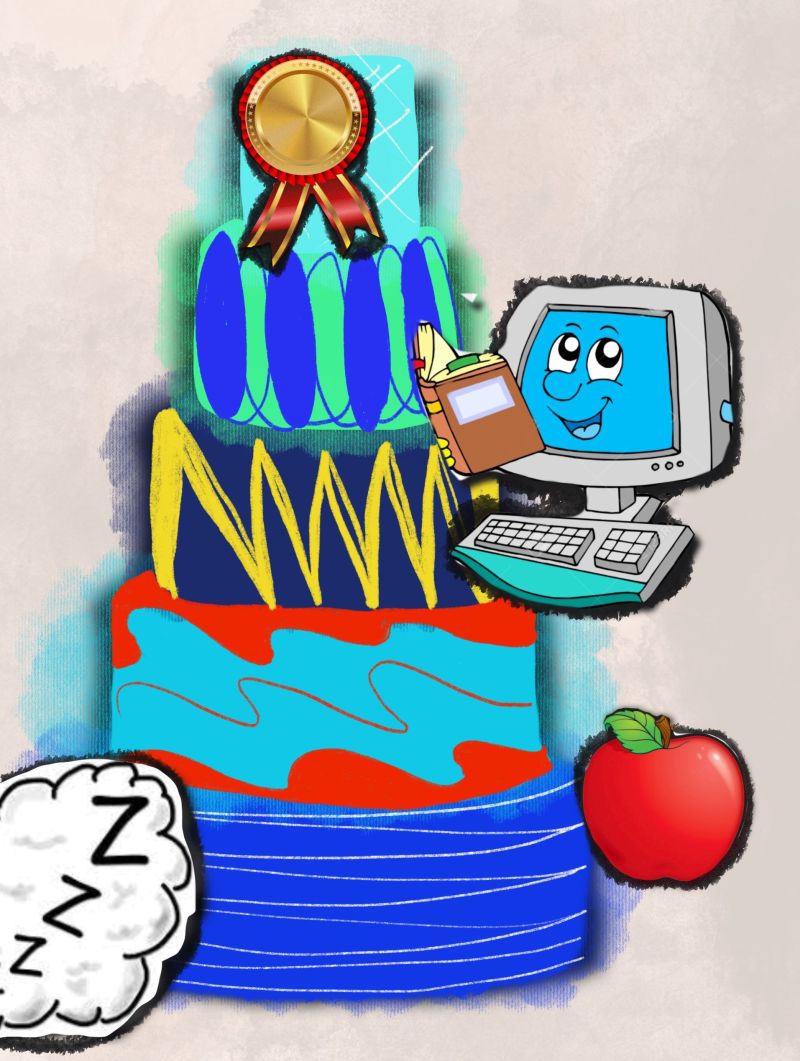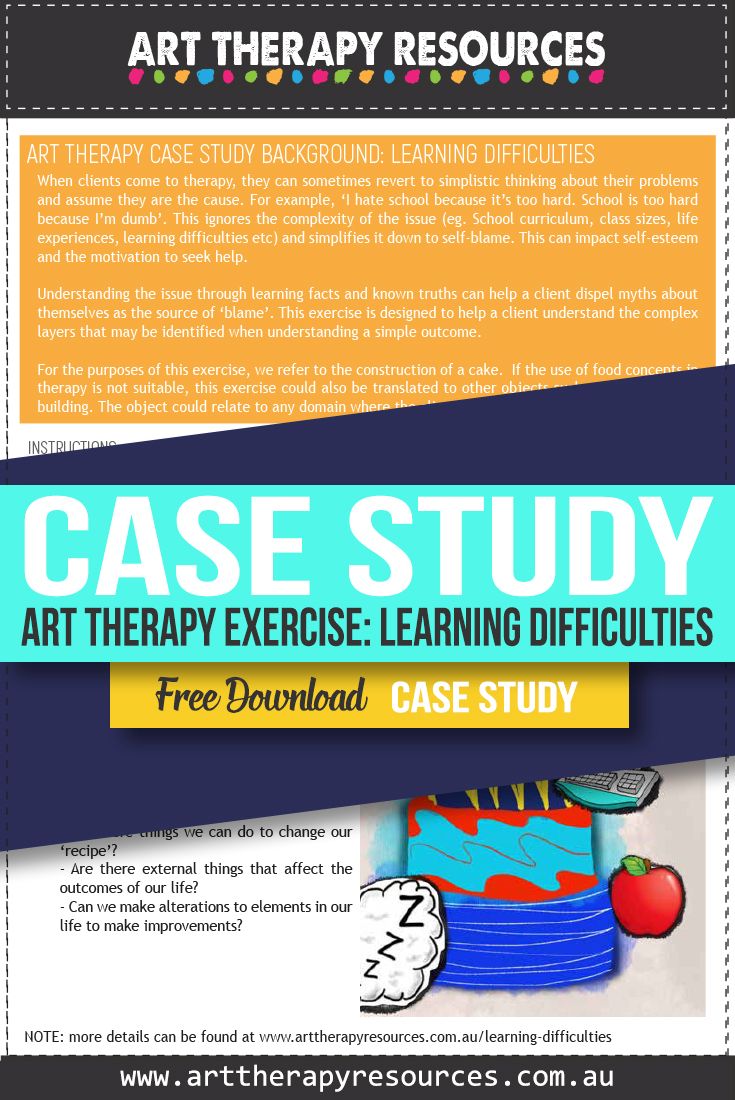THIS POST INCLUDES:
- Art Therapy and Learning Difficulties
- About the Client
- Art Therapy Exercise
- Client Insight and Outcomes
- Disclaimer
- FREE DOWNLOAD Art Therapy Exercise
ART THERAPY AND LEARNING DIFFICULTIES
Learning difficulties from an educational and medical perspective refer to a disorder based on psychological processes that involve spoken or written language and understanding that language. A learning difficulty may manifest as difficulties in listening, thinking, speaking, reading, writing, and functional use of language and mathematics.
Additionally learning difficulties can extend to perceptual disabilities and brain injuries.
Learning difficulties are primarily viewed as an effect of genetics and environmental factors interacting with the brain’s processing of information.
According to DSM-5, a learning disorder can only be diagnosed after formal education starts. To be diagnosed with a specific learning disorder, a person must meet four criteria.
1) Have difficulties in at least one of the following areas for at least six months despite targeted help:
- Difficulty reading (e.g., inaccurate, slow and only with much effort)
- Difficulty understanding the meaning of what is read
- Difficulty with spelling
- Difficulty with written expression (e.g., problems with grammar, punctuation or organization)
- Difficulty understanding number concepts, number facts or calculation
- Difficulty with mathematical reasoning (e.g., applying math concepts or solving math problems)
2) Have academic skills that are substantially below what is expected for the child’s age and cause problems in school, work or everyday activities.
3) The difficulties start during school-age even if some people don’t experience significant problems until adulthood (when academic, work and day-to-day demands are greater).
4) Learning difficulties are not due to other conditions, such as intellectual disability, vision or hearing problems, a neurological condition (e.g., pediatric stroke), adverse conditions such as economic or environmental disadvantage, lack of instruction, or difficulties speaking/understanding the language.
A diagnosis is made through a combination of observation, interviews, family history, and school reports. Neuropsychological testing may be used to help find the best way to help the individual with a specific learning disorder.
Learning difficulties are typically considered permanent for clients unless the issues occurred from an accident. In this instance, the goal may be focus on rehabilitation and a return to previous functions. In permanent learning difficulties, the goal is primarily based on working with the abilities that the client currently has.
TYPES OF LEARNING DIFFICULTIES
As understanding of learning difficulties has progressed over time, diagnosis and an understanding of learning has evolved to focus on specific areas as mentioned below:
- Intellectual disability
- Cognitive decline
- ADHD
- Dyslexia
- Dysgraphia
- Dyscalculia
- Auditory processing disorder
- Language processing disorder
- Non verbal learning disabilities (NVLD)
- Visual perceptual/visual motor deficit
This is not an exhaustive list and continues to expand as more understanding of neurological processes develops.
ISSUES WITH RECEIVING THERAPY
Psychological treatment or therapy based assistance has historically had a disconnected approach to helping those with learning disorders.
People with learning issues have often been overlooked as they were deemed unable to participate in the therapeutic process. This view is changing, however, a few issues should be taken into consideration when working with clients who have more significant learning impairments:
- Therapeutic engagement – clients with learning disorders may attend therapy through the request of family and therefore have not been a participant in the decision for them to attend therapy. This could impact engagement in sessions.
- Consent – clients with learning difficulties may not be able to give consent to therapeutic interventions
- Confidentiality – the client may be dependent on another individual and issues of confidentiality for the clients’ safety may be compromised
- Accessibility – clients with learning disorders may be dependent on others to physically attend therapy sessions. Access to treatment may be dependent on the willingness of carers. Comorbidities may also affect access to therapy.
- Communication – clients with learning disorders could exhibit difficulty with communicating and may have developed strategies with other family and friends over time to assist in communicating. These strategies, or other methods, may take time to implement with a therapist and client. Art can play an important part in the process of building communication skills.
HOW ART THERAPY CAN HELP WITH LEARNING DIFFICULTIES
Art therapy can assist people with learning difficulties as it requires less verbal interactions from the client to receive benefits from its therapeutic properties. Furthermore, artistic skill or an art background is not required to participate in art therapy.
Mastering art materials is not required to participate in art therapy which means art therapy can meet the client’s cognitive and physical abilities as they present to therapy.
Art therapy is personalised to the client and therefore the client doesn’t need to meet any minimum competency requirements to undertake art therapy.
Art therapy can assist in helping clients understand abstract concepts through imagery. This can help people who experience difficulty with verbalising thoughts and feelings. Art therapy can be less intimidating than other forms of therapy because it provides the therapist and the client an avenue to externalise the problem, feelings, and emotions. This can allow the therapist to get a thorough understanding of the client’s interpretation and insights into their experience.
Clients with learning difficulties often receive treatment that focuses on their specific learning difficulty, however, emotional issues are also prevalent for clients. These emotional issues often centre around anxiety, fear, grief, anger, frustration, identity, acceptance, attachment, and loss of autonomy. These emotional issues are often compounded by difficulty to communicate these feelings. Art therapy allows a safe space for clients to explore emotional distress.
Research has shown that in early childhood education, learning difficulties are typically addressed using academic interventions that focus on improving learning experiences. Art therapy expands this approach to encompass interventions that focus on social connections, emotional exploration, and developing insight. This approach with art therapy is especially beneficial for students who experience frustration with their academic progress amongst their peers.
For children, art therapy provides a spontaneous connection to self-expression. It gives children with language difficulties an opportunity to visualise their difficulties and develop insight and understanding into their situation by using their art.
Due to the collaborative nature of art making, clients with learning difficulties can often develop bonds with other family members through art making. This can help heal areas of conflict that may exist between family members. Art making can also strengthen the therapeutic alliance with the therapist.
ABOUT THE CLIENT
- Name: Ajay
- Age: 14
Ajay came to art therapy as part of his treatment program since being diagnosed with dyslexia 3 months ago. Ajay mentioned he didn’t understand much about dyslexia but knew he was ‘dumber’ than his classmates.
Ajay hated being called on in class to answer questions because he never knew what was being talked about. Ajay hated school and didn’t see a point in trying because he wasn’t smart enough to understand.
ART THERAPY EXERCISE
When clients come to therapy, they can sometimes revert to simplistic thinking about their problems and assume they are the cause. For example, ‘I hate school because it’s too hard. School is too hard because I’m dumb’. This ignores the complexity of the issue (eg. School curriculum, class sizes, life experiences, learning difficulties etc) and simplifies it down to self-blame. This can impact self-esteem and the motivation to seek help. Understanding the issue through learning facts and known truths can help a client dispel myths about themselves as the source of ‘blame’.
This exercise is designed to help a client understand the complex layers that may be identified when understanding a simple outcome. For the purposes of this exercise, we refer to the construction of a cake.
If the use of food concepts in therapy is not suitable, this exercise could also be translated to other objects such as constructing a building. The object could relate to any domain where the client shows an interest or understanding.
INSTRUCTIONS:
- Ask your client to choose art materials that will help them create a visual representation of a cake. This could be as simple as drawing different coloured layers on a piece of paper, choosing different coloured papers to create a collage cake, or choosing craft materials that represent components of a cake.
- Discuss with your clients what elements in their cake make the cake delicious? Is each element important in contributing to the cake tasting nice?
- Ask your client to consider how this cake might be changed so it doesn’t taste nice.
- This might mean removing items that affect the taste or adding items that impact the taste. It might mean using rotten fruit in your cake instead of fresh fruit.
- End with a discussion about how this cake can be a metaphor for various parts of us and our lives.
- Are there things in our ‘recipe’ as a person that has affected our life?
- Are there things we can do to change our ‘recipe’?
- Are there external things that affect the outcomes of our life?
- Can we make alterations to elements in our life to make improvements?
CLIENT INSIGHT AND OUTCOMES
Ajay mentioned he enjoyed creating all the different layers of his cake. He could decide what makes his cake the best.
Ajay had a discussion with his therapist about how cooking the cake at a very low or high temperature can ruin a cake. It made him see that even with the best ingredients being added to the cake, something like temperature could change how the cake came out.
Ajay said he could see how things can be successful or not can depend on many parts. It made him wonder what parts were affecting how he was able to understand things at school.

DISCLAIMER
This case study represents a snapshot of the client’s progress in treatment. The exercise in this article could be used as written or as a guide for new and original tasks developed by the Art Therapist. Responsibility for treatment resides with the individual therapist who understands their clients specific needs. The art therapy exercise should not be viewed as a pre-defined directive on how to treat a client that presents with a specific range of problems.This art therapy exercise will help build a database of knowledge to draw upon when helping your client. Art Therapy is associated with psychotherapy techniques, however each therapist often approaches therapy with their own foundation of psychological interventions, whether it be psychotherapy, CBT, DBT or other methods.
FREE DOWNLOAD: Art Therapy Exercise
Download the FREE Art Therapy Exercise based on the above Case Study. The free download includes instructions for the art therapy exercise, along with an example of the art therapy exercise.

BUILD YOUR ART THERAPY REFERENCE MATERIALS:
Pin this image to your Pinterest board.

SHARE KNOWLEDGE & PASS IT ON:
If you’ve enjoyed this post, please share it on Facebook, Twitter, Pinterest. Thank you!
